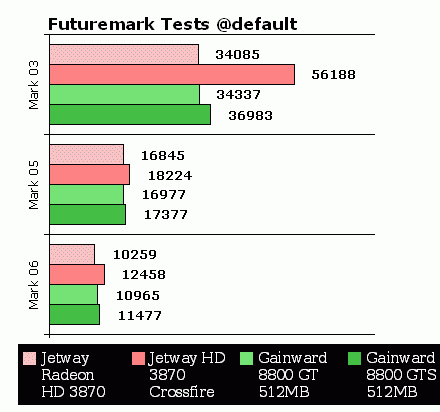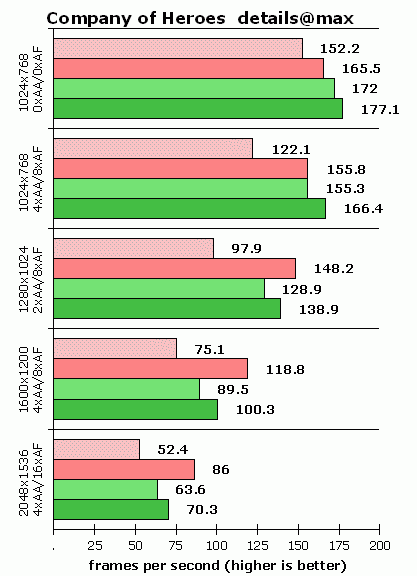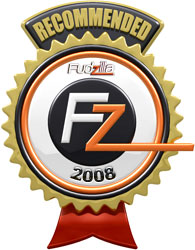Testbed:
Motherboard:
MSI K9A2 Platinum
Processor:
AMD Athlon 64 X2 6400+ (Black Edition) at 3.2HGz
Graphics cards:
Gainward 8800 GT 512MB, 
Gainward 8800GTS 512MB
Jetway Radeon HD 3870 512MB
Memory:
OCZ PC2 6400 2GB CL4-4-4-15-CR2T 800MHz
Certified By ATI
PSU:
OCZ Silencer 750 Quad Black
Hard disk:
Seagate Barracuda 7200.9 80GB SATA
CPU-Cooler:
Freezer 7 Pro
3DMarks

In 3DMark03, Crossfire has shown its true face and compared to a single card, we see the performance increase of 64%. However, 3DMark05 brings this increase all the way to 8%, while 3DMark06 brings it up to 21%.
In 3DMark06, ATI’s dual CrossFire beats 8800 GT by 13%, and 8800 GTS (G92) by 8%.
Gaming

The first game we tested, F.E.A.R, seems to really like CrossFire. At 1600x1200, two Jetway HD 3870 cards outperform 8800 GTS by 40% and 8800GT by 50%. Higher resolutions usually bring the best out of these cards, because at these workloads single card can get overburdened. At 2048x1536 Crossfire further increases its lead over 8800 GTS to 50%, and at this resolution it outperforms a single HD 3870 by 87%. Some games are capable of utilizing Crossfire or SLI, while others might give different (read worse) results.

Company of Heroes is another CrossFire-friendly game. Although you can comfortably play it on highest resolutions and detail settings using a single Jetway HD 3870 card, two cards will definitely make you a happy camper. 118 frames at 1600x1200 is definitely something to brag about. At this resolution, one card is 57% slower than two. Nvidia still holds its ground, though, and the CrossFire performance advantage is not as high as we’ve seen in F.E.A.R. Geforce 8800 GTS is slower by 18%.

ATI game Half Life 2 Episode Two didn’t fare so well on Radeon HD 3870 cards. It’s only at higher resolutions when the RV670 chips’ real power is harnessed, so CrossFire beats a single 8800 GTS. It’s a bit disappointing, but we will check whether Catalyst 8.1 improves the score. We used Catalyst 7.12. Still, 2948x1536 is playable with a single HD 3870 card.

With detail settings set on "high," World in Conflict is just too much for today’s cards to take. CrossFire manages to churn out a playable frame rate at 2048x1536, while the rest of the pack simply can’t make it.
Conclusion
You can find many CrossFire capable boards on the market today, but not many of those are quad-core Phenom ready. MSI RD790 K9A2 Platinum is one of those, and it’s also aimed at overclockers. We didn’t play with overclocking, but we definitely will soon. The board has it all, so now it’s up to AMD and Phenom to produce better overclocking models.
We based our test on a single question: Is CrossFire ready yet and is it worth buying two of the currently highest priced ATI’s cards? Those who buy two graphics cards are usually aiming at gaming, and today we’ve proven that there are advantages to buying two cards.
CrossFire loves high resolutions, and although the driver needs more polishing, it’s still faster than Nvidia’s 8800 GTS, and definitely come in handy at resolutions of over 1920x1200. Of course, if you turn on FSAA and Anisotropic filtering the performance gap between one and two cards will accordingly rise. Now it’s up to Phenom to make a phenomenal platform out of MSI K9A2 Platinum board based on the 790FX chipset with two MSI’s and Jetway’s 3870 cards. We definitely recommend this board, and for €140 it’s a bargain.

